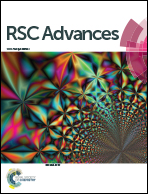Water sorption properties of room-temperature ionic liquids over the whole range of water activity and molecular states of water in these media
Abstract
The water sorption behavior for various RTILs ([C4C1im][BF4], [C4C1im][PF6], [C6C1im][PF6], [C4im][DBP], [C4im][BEHP] and [Et3HN][CF3SO3]) was studied over the whole range of water activity using a continuous gravimetric method. Analysis of the water sorption isotherms using the non-random two-liquid model (NRTL) and the combination of a dual-mode sorption (Henry-clustering) allowed a better understanding of the RTIL-water interactions. It is noticed that the sorption of water by RTILs is mainly controlled by the anion's nature. Anions interact with water molecules by hydrogen bonds that promotes the formation of a hydrogen bond network between the water molecules. The water uptake by RTILs increases in the following order (up to 0.8 in the water activity a): [C6C1im][PF6] ≤ [C4C1im][PF6] < [C4C1im][BF4] ≈ [C4im][BEHP] < [Et3HN][CF3SO3] ≤ [C4im][DBP]. The [PF6]-based RTILs show the lowest water uptake (low affinity with water; water-immiscible RTILs), whereas [C4C1im][BF4] and [C4im][BEHP] and especially [C4im][DBP] and [Et3HN][CF3SO3] exhibit high water uptake (high affinity with water; water-miscible RTILs). At high activity (a > 0.8), water molecules are aggregated only in water-miscible RTILs (case of [C4im][DBP] and [Et3HN][CF3SO3]) because of their stronger anion basicity. To complete the sorption study, the molecular state of water dissolved in RTILs was studied by the infrared spectroscopy. The water molecules dissolved in water-immiscible RTIL such as [C4C1im][PF6] are not self-associated independently of the water content and, thus, can be defined as “free” water molecules interacting via H-bonding with the anions in the symmetric complex: anion⋯HOH⋯anion. On the contrary, the water molecules sorbed in water-miscible RTILs such as [C4im][DBP] or [Et3HN][CF3SO3] are strongly associated by H-bonds and also with the anions even at low water activity, and are easily aggregated when the water content reaches the critical concentration at high activity.


 Please wait while we load your content...
Please wait while we load your content...